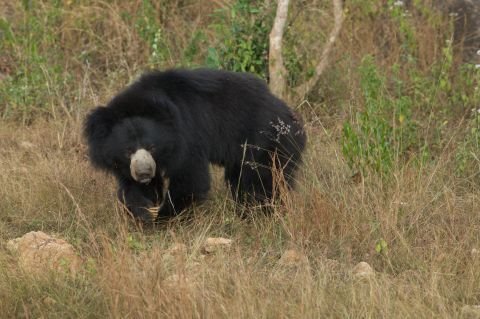
We are celebrating the first ever World Sloth Bear Day on 12 October and are calling for greater measures to protect sloth bear populations. During the past 20 years, International Animal Rescue (IAR) has worked with Wildlife SOS (WSOS) in India to rescue and care for dancing bears in sanctuaries throughout India.
Wildlife SOS, involved in sloth bear conservation and protection for more than 25 years, recently proposed to the IUCN (International Union for the Conservation of Nature) that 12 October be declared “World Sloth Bear Day.” This unique bear species is endemic to the Indian subcontinent and listed as ‘Vulnerable’ on the IUCN Red List. The IUCN-SSC Sloth Bear Expert Team accepted the proposal and is encouraging recognition of the day across the world.
World Sloth Bear Day will provide an opportunity for organisations, institutions, rescue centres and nature reserves around the world to promote the conservation of sloth bears and their habitats, accelerate research and raise public awareness about this lesser-known species around. Sloth bears are often confused with the slow-moving arboreal South American sloths. In reality, sloth bears are agile and considered to be one of the most formidable wild animals.
To commemorate the first World Sloth Bear Day, Wildlife SOS and the IUCN -SSC Sloth Bear Expert Team are hosting an inaugural event at the Agra Bear Rescue Facility in Uttar Pradesh on 12 October 2022. This is the world’s largest Rescue and Rehabilitation Centre for Sloth Bears, established by Wildlife SOS in collaboration with the Uttar Pradesh Forest Department in 1999 and provided with ongoing financial support from International Animal Rescue since 2002.
The Sloth Bear (Melursus ursinus) is one of the eight bear species found across the globe. They can be identified by their very distinct long, shaggy dark brown or black fur, distinct white V-shaped chest patch and four-inch long ivory-coloured curved claws used for digging out termites and ants from rock-hard mounds. In the Indian subcontinent, they range across the country through the Deccan plateau, coastal areas, Western Ghats and to the base of the Himalayas.
Today, 90% of the global sloth bear population is found in India. According to several reports, their population has dropped by 40 to 50% over the last three decades mainly due to habitat loss, habitat fragmentation, poaching and increasing human-bear conflict.
The (Wildlife Protection) Act of India, 1972 lists the sloth bear under Schedule I, granting this species the same level of protection as tigers, rhinos and elephants. However, this keystone species has mostly been fighting a long uphill battle for survival and urgently deserves conservation and protection measures.
These bears were previously captured for entertainment in the barbaric ‘Dancing bear’ practice in India. With the support of International Animal Rescue, Wildlife SOS rescued and rehabilitated over 628 performing dancing bears, bringing a 400-year-old barbaric tradition to an end. They also provided alternative livelihoods to the nomadic Kalandar community members, empowering the women and educating the children to prevent them from carrying on this illegal and cruel tradition.
Alan Knight, OBE, President of International Animal Rescue, said: “Since working with our partners Wildlife SOS to rescue dancing bears off the streets of India, I have come to appreciate what remarkable creatures sloth bears are. In spite of their resilience and adaptability, their population in the wild is declining owing to human activity, habitat loss, poaching for body parts and human-bear conflict. At International Animal Rescue we are extremely proud of the work we do with Wildlife SOS to protect and conserve sloth bears in India. We will certainly be marking 12 October as a special day for sloth bears and using it to increase awareness of the species and the many threats it currently faces. With only 6,000 to 11,000 sloth bears left in the wild in India, it is imperative to take action to conserve remaining populations.”
Kartick Satyanarayan, Co-founder and CEO, Wildlife SOS said: “This day is a rallying call for people around the world to learn about this little known species and promote the conservation of sloth bears so we never see a day without this species. The public can help conserve India’s sloth bears by learning about their habitats and supporting organisations actively working to protect them. We are grateful to the Forest Dept and the Minisitry of Environment and Forestry, and our partner organisation IAR, for their kind and continued support of our work over the decades.”
Nishith Dharaiya Co-chair of the IUCN Sloth Bear expert team said: “In many ways, Sloth bears are the most unique of all bear species, they carry their young on their back for 6-9 months, 50% of their diet is made up of termites and ants and they have the ability to chase off a full grown tiger. Unfortunately, they face ever-increasing pressures from habitat loss and fragmentation as well as from other anthropogenic risks including illegal poaching. World Sloth Bear Day is a time to pause and reflect on the importance of protecting this truly unique species.”
Geeta Seshamani, Co-founder & Secretary Wildlife SOS said: “Sloth Bears have inhabited the Indian subcontinent for nearly 2 million years. They are the least researched bears in the world and we have a lot of mysteries to uncover about this unique species. It is our hope that 12 October every year will stand as a day to focus on sloth bear conservation worldwide.

